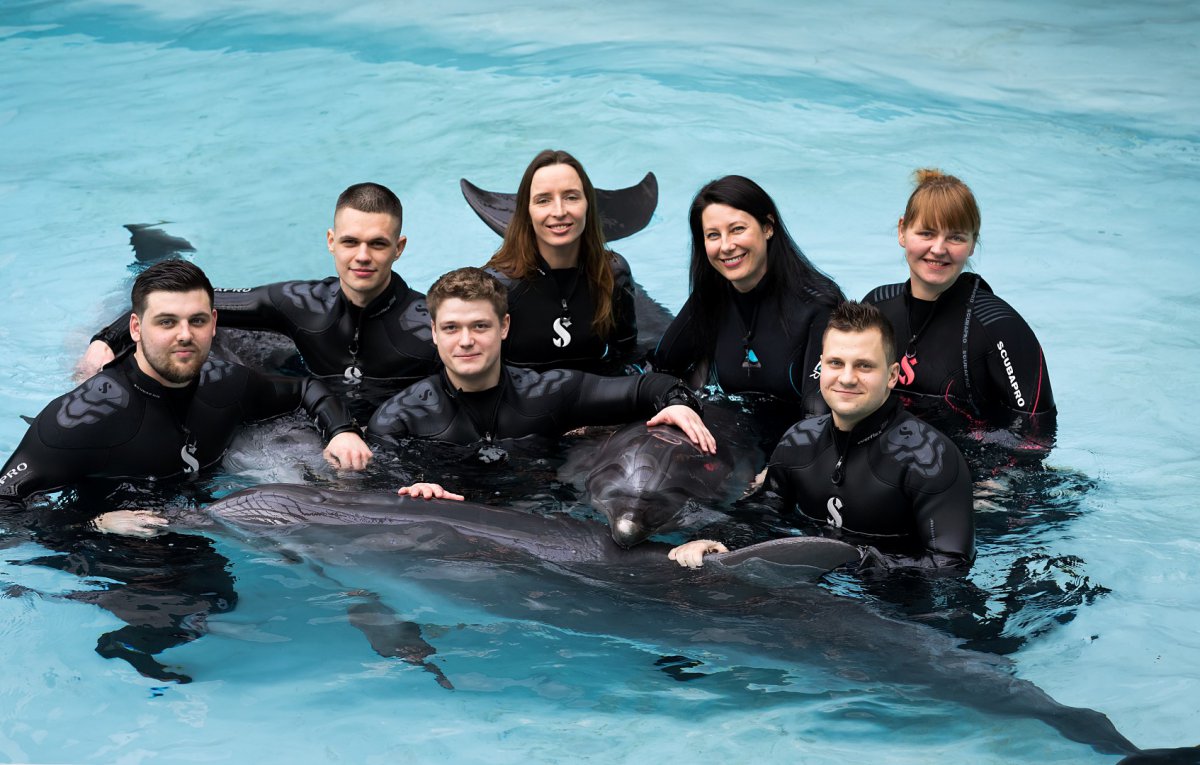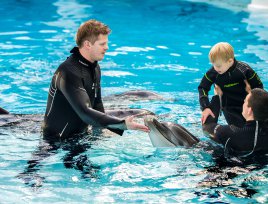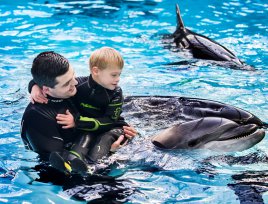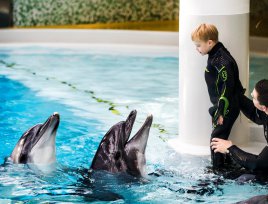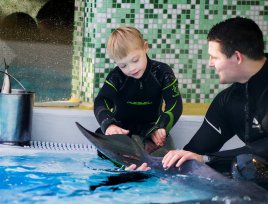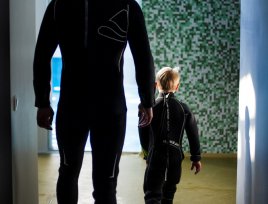The initiative of interacting with dolphins started back in 2002. More than a decade later, in 2015, a Dolphin-Assisted Therapy Centre was also established
This centre provides therapy for children and adults with various disabilities. In the first year, dolphins interacted with children with autism and later began socialising with people with Down syndrome, those suffering from oncology, cerebral palsy and other diseases.
While working in a therapy centre, dolphins choose who they want to interact with – interestingly, in this area of activity, they do not get encouraged with fish and constantly amaze with their ability to find a common ground with a wide variety of people. Dolphins are sensitive to the emotional state of their guests and can adapt to it. As a result, one of the first effects of therapy visitors can notice is a massive influx of positive emotions.
Therapy sessions usually involve the entire team of professionals: a dolphin trainer, a psychologist, a physiotherapist, a behavioural specialist and a social worker. In 2013, the Dolphin Assisted Therapy Programme was validated by the order of the Minister of Health of the Republic of Lithuania as a health promotion service. It is a European precedent whereby dolphin therapy is regulated by the Ministry of Health documents.
In addition to direct assistance to visitors, the Dolphin-Assisted Therapy Centre is also a place where research is conducted, conferences are held and scientific articles are published.
Registration to the Dolphin assisted therapy program is available every year. Attention to those, who is willing to register for the next period. Not less than 4 months before the registration scheduled day, information about opening registration day and hour is announced. Preliminary date for the next registration is in 2024.
Price for one therapy session with dolphins is 120 Eur, duration of session is 30 minutes. For one participant 10 sessions with dolphins are planned.
At the moment we have few spear places starting from November for participating in the additional programmes:
Consultation of specialists and individual movement, neurosensorymotor, snoozelen activities. Registration by phone: (+370 46) 46 10 10
Sessions of interaction with dolphins. What is it?
Dolphin Assisted Therapy Center organizes individual or group sessions of interaction with dolphins are designated for people having physical, mental or situational issues as well as for people suffering from neurological diseases and/or having experienced psycho-emotional traumas. It helps to improve their well being and develops their cognitive and socialization skills. Sessions of interaction with dolphins cannot replace traditional therapeutic services. Sessions of interaction with dolphins are organized according to the HN 133: 2013 of the Ministry of Health of the Republic of Lithuania.
Founder of the dolphin assisted therapy David E. Nathanson, a neuro-psychologist and behaviour investigator, found out that disabled children react more positively to the interaction with dolphins rather than other animals. During the therapy sessions, dolphins interact with children and adults using toying elements, allowing them to relax better. Due to this, information is easier grasped and memorized, attention is better focussed, psycho-social behaviour and communication elements are developed and children's psycho-emotional condition is improved. Dolphins are very curious animals. The essence of the therapy lies in dolphins' capability to develop and maintain toying behaviour longer than any other mammal. Such fact proves their high level of emotional behaviour. David E. Nathanson systematized practical information and developed a concept of dolphin assisted therapy that enhances positive factors of humans. In cases of grave communication disturbances, the very encounter with a dolphin performs the function of an ‘ice-breaker’, which stimulates positive changes in psycho-social and psycho-emotional contacts and leads to further therapeutic activities.
Each year Dolphin Assisted Therapy Center organizes scientific research on particular dolphin-human welfare topics. The research participants are invited to participate in the holistic dolphin assisted therapy program free of charge. The research is organized to gather data in three branches: psychoemotional, physical rehabilitation, and sensory. Check out current research possibilities.
Target groups
Interaction with dolphins ensures positive emotions; water environment allows professionals to use physical rehabilitation or sensory aspects. Sessions of interaction with dolphins are suitable for everyone experiencing difficult situations in life. Dolphins have incredible abilities to feel emotions and understand gestures. They ask for attention by addressing people, playfully throwing a ball or splashing water. Sessions are organized for children and adults. When child or adult is participating in the sessions of interaction with dolphins, caregivers can participate observing the session. When parents watch their child interacting with dolphins get to know him/her better, thus a new stronger and closer mutual relation is formed.
Generally, the dolphin assisted therapy is applied all over the world for patients with autism, Down syndrome, haemophilia, cancer, fibrosis, congenital heart diseases, cerebral palsy, arthritis, diabetes, depression, AIDS, drug addiction or alcoholism. Though, irrespective of global practice, it is necessary to assess the possible negative effect for the participant (due to animal behaviour, cold water, salinity or possible allergic reactions) in every individual case. Almost in all countries the dolphin assisted therapy is not applied at all and/or applied using extra safety measures (e.g. without getting into the water) for patients with epilepsy, fragile bone system, stoma(s), open wounds or Down syndrome.
How are sessions of interaction with dolphins being conducted?
Our model of organization the sessions of interaction with dolphins contains the principles that interaction is both-sided enjoyable process between dolphin and participant. It is essential that professionals (social worker, physiotherapist, psychologist, specialist of structured teaching) takes the best care and organize sessions of interactions for person with disability and biologists / marine mammal behavior professionals take the best care of dolphins during this interaction. The sessions of interaction with dolphins are facilitated by meeting individual needs of person with disability and dolphin.
Full program of sessions of interaction with dolphins include ten sessions with dolphins (30 minutes each, Mon-Fri), six complementary educational and therapeutic activities which are organized individually meeting the needs of person with disability. When full program is ordered, complementary activities are included into package, otherwise, additional programs can be bought separately or without ordering sessions with dolphins (PRICES). Additional programs are suggested to meet the needs of client. The following additional programs are available: a specialist's consultation, Sherborne developmental movement, video analysis, body alignment, massage, sensory integration techniques, music therapy, TEACCH structured learning, HOP intensive interaction, video analysis or relaxation techniques. Special rooms for family resting are available in the Dolphin Assisted Therapy Centre as well as playground for children. The Dolphin Assisted Therapy Centre became a home for some reptiles - geckos, iguanas and turtles - who participate in the educative activities as well. Our aim is to support the whole family, as it is believed that the issue of one family member tends to increase stressful situation of the whole family.
Factors involved
The sessions of interaction with dolphins positively improves psycho-emotional and physical development for children and adults. The sessions take place in a pool adapted for the client, with inclusive environment. The sessions in the water has beneficial effect on psychological interaction with emotions, development of tactile and vestibular systems and perception of a body as a certain system.
The purpose of the Dolphin Assisted Therapy Centre is to develop wellness, research and cognitive activities relating to the dolphin assisted therapy and other types of therapy that meet social, cultural, educational and health improvement needs of the society while ensuring animal well-being. Priority is given to families facing severe disability, psycho-emotional and psycho-social problems.
The Dolphin Assisted Therapy Centre provides holistic support for families
Multidisciplinary team of Dolphin Assisted Therapy Center works realizing main principles:
the principle of animal well-being;
the principle of holistic approach – the therapy process is orientated towards seeking a physical and psychological sense of coherence with nature and oneself. Attention is paid to the whole family, not only to the patient alone;
the principle of ethics – privacy, confidentiality, respect to the human rights and dignity, honesty, responsibility, unconditional acceptance, equal participation, equal use of resources of society, etc.
In order to ensure the proper quality of services provided in the Dolphin Assisted Centre, the specialists apply recognized techniques ensuring actual results (Watsu/Tantsu (intense relaxation technique used in water), Sherborne developmental movement, sensory integration, TEACCH (structured education program), OIVA (interaction with environment model), HOP (hanging out program) and intense interactions). The employees of the Centre continuously participate in various training programs in Lithuania and abroad. The carried out scientific research proves that application of such techniques and/or models significantly improves the quality of life of the disabled people and facilitates their social integration.
Price list
| Art Therapy in the Dolphin Assisted Therapy Centre | 30 min | 20 € | For children and adults with disabilities or psychosocial challenges. |
| Relaxation Therapy in the Dolphin Assisted Therapy Centre | 30 min | 20 € | For children and adults with disabilities or psychosocial challenges; for client family members |
| Movement Therapies: Sherborne developmental movement (individual or with group), Body adjustment, traditional physiotherapy*, manual physiotherapy*, massage* in the Dolphin Assisted Therapy Centre |
30 min | 20 € | For children and adults with disabilities or psychosocial challenges; for client family members |
| Snoozelen therapy in the Dolphin Assisted Therapy Centre | 15 min | 20 € | For children and adults with disabilities or psychosocial challenges; for client family members |
| Forest approach through five senses – group therapy | 2 hours | 0 € | for families participating in therapeutic sessions with dolphins in Smiltyne forest |
| Consultations with specialists, lecture/seminar on methods in Dolphin Assisted Therapy Centre | less than 1 hour | 200 € + VAT tax | |
| Consultation with Psychologist in Dolphin Assisted Therapy Centre | less than 1 hour | 50 € + VAT tax | |
| TEACCH consultation in Dolphin Assisted Therapy Centre | less than 1 hour | 50 € + VAT tax | |
| HOP video analysis in Dolphin Assisted Therapy Centre | less than 2 hour | 100 € + VAT tax | |
| OIVA video analysis in Dolphin Assisted Therapy Centre | less than 2 hour | 100 € + VAT tax | |
| Consultation with specialist of sensory integration in Dolphin Assisted Therapy Centre | less than 1 hour | 50 € + VAT tax | |
| Consultation with specialist of movement in Dolphin Assisted Therapy Centre | less than 1 hour | 50 € + VAT tax |
The contact of employees of the Dolphin assisted therapy department
The Head of the Department Dr. Brigita Kreivinienė
+370 46 46 10 10, b.kreiviniene@muziejus.lt
Chief Specialist Deividas Žadeikis
+370 659 21 928, d.zadeikis@muziejus.lt
Chief Specialist Vaida Vaišvilaitė
+370 659 21 928, v.vaisvilaite@muziejus.lt
Specialist Dovydas Mačiulskas
+370 659 21 928, d.maciulskas@muziejus.lt
Specialist Jokūbas Pajarskas
+370 659 21 928, j.pajarskas@muziejus.lt
Specialist Vilhelmas Trynkinas
+37065921928, v.trynkinas@muziejus.lt
Parents' comments after dolphin assisted therapy sessions
About the son (a five-year-old boy with an autism spectrum disorder): "The child started communicating with his peers, became more curious and started talking and drawing. He is more affectionate, stereotypical movements are not so frequent, he stays focussed for a longer period of time."
About the son (a fifteen-year-old boy with cerebral palsy): "The speech has improved, logical thinking is observed, he has become more curious, orientation has improved, he wants to stand up and make steps with the help of a walker. After the sessions, the child's body has become more relaxed, he grabs things more easily."
About the daughter (a nine-year-old girl with an autism spectrum disorder): "The girl's appetite and sleep improved after several sessions. She has become more calm and is not so much afraid of new situations, like earlier. Upon returning home she embraced and kissed her little brother (she had never done that before). The most significant change is the fact that she uses more sounds and syllables in her daily routine and tries to mimic."

